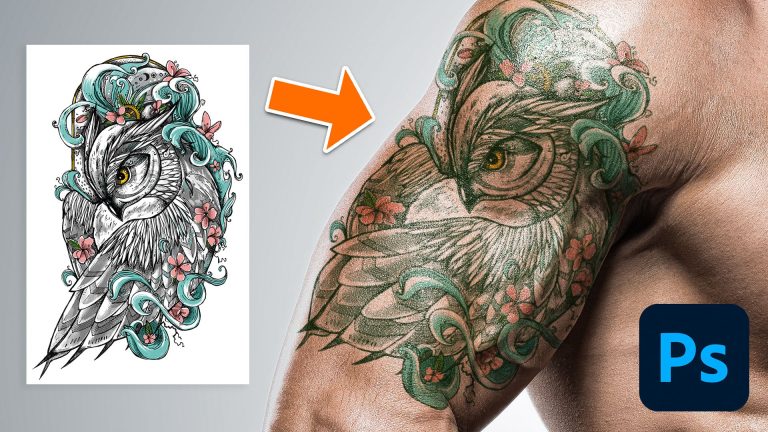Ink Perfection: A Comprehensive Pro’s Step-by-Step Guide to Applying Tattoos in Photoshop

Introduction:
The allure of tattoos lies in their ability to express individuality, creativity, and personal narratives. In the realm of digital art and design, Photoshop serves as a dynamic canvas where one can experiment with various visual elements, including lifelike tattoos. In this extensive guide, we’ll navigate the intricate process of applying tattoos in Photoshop, unraveling professional-level techniques step by step. Whether you’re a digital artist, a photographer seeking to explore temporary ink options, or simply an enthusiast eager to enhance your images, this guide empowers you to master the art of tattoo application with precision and finesse.
1. Understanding the Significance of Digital Tattoos:
Digital tattoos open up a realm of creative possibilities, allowing artists and enthusiasts to experiment with body art without the permanence of the real thing. Photoshop provides the ideal platform to test, refine, and visualize tattoo concepts before committing to the ink in the physical realm.
2. Choosing the Right Image:
Select a high-resolution image as your canvas—whether it’s a photograph of a person or a digital portrait. Ensure that the image quality is sufficient to capture the intricacies of both the skin and the desired tattoo design.
3. Identifying the Tattoo Placement:
Determine the placement of the tattoo on the skin. Photoshop’s transformative capabilities allow you to experiment with various positions, sizes, and orientations. Consider the contours of the body, skin tone, and natural lighting when deciding on the ideal placement.
4. Creating a New Layer:
Before delving into the tattoo application process, create a new layer in Photoshop. This layer will serve as the canvas for your tattoo, ensuring that your edits remain separate from the original image. This approach provides flexibility and the option to refine your tattoo design at any stage.
5. Choosing the Right Tattoo Design:
Select or create the tattoo design you wish to apply. Pay attention to the style, size, and details of the tattoo, ensuring it complements the aesthetics of the image and aligns with the desired visual impact.
6. Adjusting Tattoo Size and Placement:
Using Photoshop’s transformation tools, such as Free Transform or Warp, adjust the size and placement of the tattoo to align with the contours of the body. Take into account factors like perspective, curvature, and skin texture to achieve a realistic and seamlessly integrated appearance.
7. Blending and Matching Skin Tones:
To create a lifelike effect, focus on blending the tattoo with the skin tones of the original image. Adjust the opacity and blending mode of the tattoo layer to seamlessly merge it with the skin. Experiment with Hue/Saturation adjustments to match the color tones, ensuring a harmonious blend.
8. Adding Realism with Layer Styles:
Enhance the realism of the tattoo by applying layer styles. Consider adding a subtle drop shadow to mimic the natural shadowing that occurs on the skin. Experiment with inner and outer glows to simulate the slight shine that tattoos often exhibit.
9. Refining Details with Brushes and Masks:
Fine-tune the details of the tattoo by using brushes and masks. Refine edges, add texture, or erase parts of the tattoo to create a seamless integration. The use of soft brushes and precise masking techniques is crucial in achieving a natural, non-intrusive appearance.
10. Checking for Consistency and Final Adjustments:
Zoom out and assess the overall image for consistency. Ensure that the tattoo looks organic and aligns with the body’s natural features. Make final adjustments to color, saturation, and contrast to achieve a cohesive and visually appealing result.
Conclusion:
Applying tattoos in Photoshop is an art form that demands a meticulous blend of creativity, technical skill, and attention to detail. Whether you’re exploring the world of digital body art for artistic expression or refining portraits for creative projects, mastering the steps outlined in this guide empowers you to create stunning, realistic tattoos that seamlessly integrate with your digital canvases.
Photoshop’s versatility as a design tool opens up endless possibilities for artists, photographers, and enthusiasts alike. The ability to experiment with tattoos in a digital space not only allows for creative exploration but also serves as a valuable resource for individuals contemplating permanent ink. As you navigate the process of applying tattoos in Photoshop, remember that precision, thoughtful design choices, and a keen eye for detail are key elements in achieving professional-level results. Embrace the digital canvas, let your creativity flow, and witness the transformative power of tattoos brought to life in the realm of pixels and possibilities.







